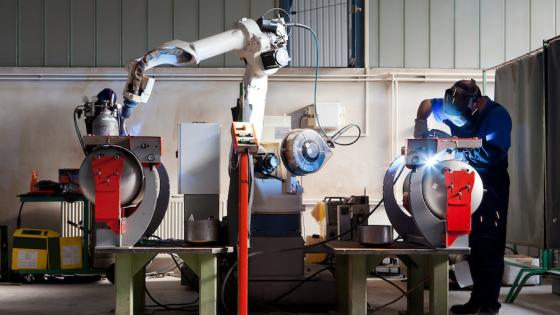The debate as to whether or not technological change replaces more jobs than it creates dates back to the 18th century. Yet, it continues to resonate in recent policy discussions (Mokyr et al. 2015). Fuelled by striking numbers, such as 47% of US jobs at high risk of becoming automated in the near future (Frey and Osborne 2017), policymakers, managers, and researchers are increasingly investing effort to help adapt labour markets and social systems for a time when most of the tasks performed by humans would be executed by machinery. This trend has been accompanied by a surge of economic research on interactions between technology, labour, and the economy.
Technological change can affect labour through various channels
Both empirically and theoretically, the effects of technological change on labour can arise through multiple channels. Many technologies are designed to save human labour by replacing workers with machinery. However, economic theory suggests that several compensating mechanisms can counterbalance the initial labour-saving impact of new technologies (Acemoglu and Restrepo 2019, Baldwin et al. 2021). First, technological change can increase the demand for labour by creating new jobs that are directly associated with the new technology. Furthermore, technology-induced increases in productivity release production resources that can raise the demand for labour in other tasks within the same firm or industry.
Second, technology can raise the demand for labour through increased consumer demand. This occurs when new technologies boost productivity growth and, in turn, lead to lower production costs and consumer prices. Moreover, new technologies can raise the marginal product of labour and capital, resulting in both higher wages and returns to capital. The two latter effects contribute to a rise in real income. If demand is sufficiently elastic and positively responds to increases in income and decreases in prices, technologies can stimulate a demand-induced expansion of output (Bessen 2020).
Systematically reviewing the empirical evidence on technology and employment
In a recent paper (Hötte et al. 2022) we refer to these channels as (1) replacement, (2) reinstatement, and (3) real income effect, and analyse their empirical basis through a systematic literature review.
We identify 127 relevant studies providing evidence on technological change and its impact on employment during the past four decades. Aiming to capture the impact of technological change at the frontier, we focus on studies looking into industrialised economies. Furthermore, to uncover potential underlying heterogeneity, we pin down five broad categories of technology measures that are predominantly studied in the literature by distinguishing between: (1) information and communication technology (ICT); (2) robot-diffusion; (3) innovation surveys; (4) productivity; and (5) a residual category that contains various alternative indicators.
Labour-creation mutes the labour-replacing impact of technologies
We find that the number of studies that support the labour replacement effect is more than offset by the number of studies that support the labour-creating/reinstating and real income effects (Figure 1, Panels a-c). This observation is reaffirmed when looking at the studies that analyse the net employment effect of technological change, which in turn suggests the net impact of technology on labour to be rather positive than negative (Figure 1, panel d).
Figure 1 Share of studies by type of result reported for each effect examined
Source: Calculations based on 127 studies collected from systematic literature review in Hötte et al. (2022).
Findings are heterogeneous across technology groups
The findings for the five distinct technology categories show broadly similar patterns, but with some subtle differences which are worth highlighting.
- ICT: There is no evidence that the replacement effect dominates the reinstatement and real income effects combined. However, the results suggest that the reinstated jobs qualitatively differ from the jobs replaced. The diffusion of ICT mostly has positive employment implications for high-skill, non-routine, and service jobs.
- Robots: We observe that the labour-saving impact is generally offset by robot-induced reinstatement of labour. In contrast to the ICT studies, robot studies tend not to touch upon the complementarity between robots and human labour in the performance of tasks. Hence, the labour-creating effect of robots is most likely related to the production, operation, and maintenance of this type of technology.
- Innovation: Studies that rely upon innovation as a measure of technology often argue that the employment impact depends on the type of innovation. While product innovation is shown to be mostly labour-creating, the evidence on the employment impact of process innovation remains mixed.
- Productivity: When considering productivity improvements as a proxy for technological change, we find a roughly equal balance between the number of empirical studies that provide support for the replacement and the two labour-creating mechanisms. The employment gains have been mostly favourable for non-production, high-skill, and service jobs. These studies are often linked to theories that argue that technological change leads to structural change with a reallocation of economic activity down the supply chain from more primary towards increasingly processed sectors and services. Nonetheless, the net employment effects observed in these studies are rather negative than positive.
- Other: Lastly, the findings from studies that rely on other/indirect measures of technology indicate that the labour replacing effect is offset by the labour-creating effect. The employment effects have been mostly positive for non-production labour, yet some studies also find positive employment effects for low-skilled workers, particularly in service jobs.
Anxieties over widespread technology-driven unemployment lack an empirical base
Although we find larger support for the labour-creating effects of technological change, we are careful in concluding that technology has a positive net effect on employment. Nevertheless, we do safely conclude that the labour replacing effect of technology is typically offset by a range of compensating mechanisms that lead to labour creation or reinstatement. Hence, there does not appear to be an empirical foundation for the fear of technology-driven massive unemployment.
Despite the fact that we find no strong evidence for a negative net employment effect in quantitative terms, the qualitative impact and distributional aspects of technological change on employment cannot be neglected. In particular, low-skill production and manufacturing workers have been adversely affected by technological change (Blanas et al. 2019). Hence, effective upskilling and reskilling strategies should remain at the forefront of policymaking. Many occupations in both the lower and middle part of the skill distribution will continue to evolve and demand a changing set of skills due to technological progress. Therefore, employment perspectives of relatively vulnerable groups can be significantly improved by investing in the right skill sets. Nonetheless, some workers who experience job losses might not be able to engage in upskilling or make the transition to new jobs. For these groups, targeted social support systems will remain important.
Summing up and the road ahead
To the best of our knowledge, ours is the most comprehensive systematic literature review on the technology-labour nexus, and it is the first that carefully distinguishes different technologies and channels of impact. This study offers an empirical basis for the political and scientific debate on the labour market effect of technological change.
However, while the empirical studies considered in this work mostly cover the impact of widely diffused technologies, the scope of tasks that may be automated in the near future is continuously expanding (Brynjolfsson and McAfee 2014). Empirical evidence on the impact of artificial intelligence, quantum computing, virtual reality, biotechnology, nanotechnology, renewable energy, and other emerging technologies that will soon impact our economy remains limited.
In fact, none of the studies in this column assesses the impact of this new wave of technological innovation. To that end, it is unclear to what extent our findings can be extrapolated into the future (Baldwin 2020); real-time monitoring and ongoing research is needed to more fully understand the emerging impact of the introduction of new technologies on the future of work.
References
Acemoğlu, D and P Restrepo (2019), “Automation and New Tasks: How Technology Displaces and Reinstates Labor”, Journal of Economic Perspectives 33(2): 3–30.
Baldwin, R (2019), The globotics upheaval: Globalization, robotics, and the future of work, Oxford University Press.
Baldwin, R, J I Haaland, and A J Venables (2021), “Jobs and technology in general equilibrium: A three-elasticities approach”, CEPR Discussion Paper 15739.
Bessen, J (2020), “Automation and jobs: when technology boosts employment”, Economic Policy 34(100): 589–626.
Blanas, S, G Gancia, and S Y Lee (2019), “Machines and workers: How different technologies affect different workers”, VoxEU.org, 10 October.
Brynjolfsson, E and A McAfee (2014), The second machine age: Work, progress, and prosperity in a time of brilliant technologies, WW Norton & Company.
Frey, C B and M A Osborne (2017), “The future of employment: How susceptible are jobs to computerisation?”, Technological Forecasting and Social Change 114: 254–280.
Hötte, K, M Somers, and A Theodorakopoulos (2022), “Technology and jobs: A systematic literature review”, Oxford Martin Working Paper Series on Technological and Economic Change No. 2022-2.
Mokyr, J, C Vickers, and N L Ziebarth (2015), “The history of technological anxiety and the future of economic growth: Is this time different?”, Journal of Economic Perspectives 29(3): 31–50.







